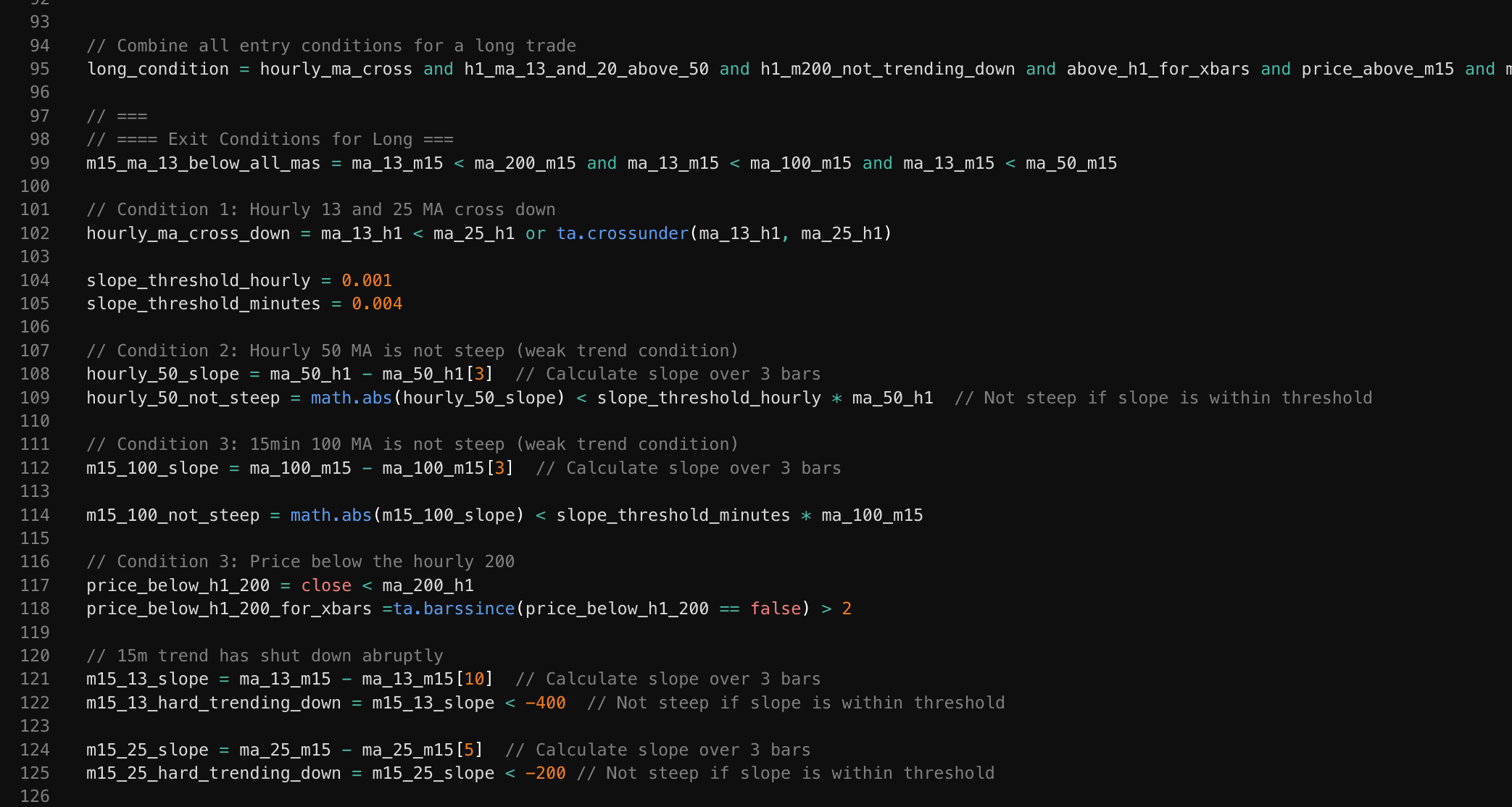Custom Indicator Combinations: Building Your First Trading System in PineScript
Learn how to build your first custom trading system by combining multiple indicators in TradingView's PineScript. This step-by-step guide covers selecting complementary indicators, implementing entry and exit logic, and optimizing your strategy for consistent performance.

For beginner traders, the transition from using pre-built indicators to creating custom trading systems represents a significant leap in trading capability. By combining multiple indicators in TradingView's PineScript language, you can develop unique strategies that align perfectly with your trading style and goals. This comprehensive guide will walk you through the process of building your first custom trading system using PineScript, empowering you to move beyond basic chart analysis and into the world of personalized strategy development.
What You'll Learn
- Understanding the core principles of effective trading systems
- How to select complementary indicators for your strategy
- Step-by-step PineScript coding for indicator combinations
- Implementing entry and exit logic in your system
- Backtesting and optimizing your custom strategy
- Common mistakes to avoid when building indicator systems
Why Create Custom Indicator Combinations?
While single indicators provide valuable information, they often generate false signals when used in isolation. By strategically combining multiple indicators that analyze different aspects of market behavior, you can:
- Filter out false signals by requiring confirmation from multiple sources
- Capture different market conditions such as trend, momentum, and volatility
- Develop a unique edge that isn't available in standard indicator settings
- Adapt to specific trading instruments and timeframes with customized parameters
The most successful traders don't rely on generic strategies—they build systems tailored to their specific trading approach. PineScript makes this customization accessible even to those new to coding.
Selecting Complementary Indicators For Your First System
The key to an effective trading system lies in combining indicators that analyze different aspects of market behavior. For your first custom strategy, we recommend focusing on three core components:
1. Trend Identification Indicator
Trend indicators help determine the overall market direction. Popular choices include:
- Moving Averages (MA): Simple to implement and interpret, moving averages smooth price action to reveal the underlying trend. The 50-period and 200-period EMAs are particularly valuable for trend identification.
- Average Directional Index (ADX): Measures trend strength regardless of direction, with readings above 25 generally indicating a strong trend.
2. Momentum Indicator
Momentum indicators reveal the speed of price movements and potential reversal points:
- Relative Strength Index (RSI): Identifies overbought and oversold conditions, with potential to spot divergence between price and momentum.
- MACD (Moving Average Convergence Divergence): Shows momentum shifts through the relationship between two moving averages and a histogram.
3. Volume or Volatility Indicator
These indicators provide confirmation and timing precision:
- On-Balance Volume (OBV): Helps confirm price movements by showing whether volume is flowing in or out of an asset.
- Bollinger Bands: Displays volatility through adaptive bands that widen during volatile periods and contract during low volatility.
For our example system, we'll combine an Exponential Moving Average (EMA) crossover for trend identification, RSI for momentum analysis, and volume confirmation for trade validation.
PineScript Basics: What You Need to Know
Before diving into our custom strategy, let's cover some PineScript fundamentals:
// Comments begin with double forward slashes
// This is the basic structure of a PineScript strategy
//@version=5
strategy("My Strategy Name", overlay=true)
// Variable declaration
myVar = close
// Conditional statements
if (condition)
// Do something
else
// Do something else
// Plotting
plot(myVar)
// Strategy entry/exit
if (buyCondition)
strategy.entry("Buy", strategy.long)
if (sellCondition)
strategy.close("Buy")
Key PineScript concepts to understand:
- Variables: Store values for later use
- Arrays and Series: Collections of values across bars
- Functions: Reusable blocks of code
- Conditional logic: Make decisions based on indicator values
- Plotting: Visualize indicators on your chart
Building Your First Multi-Indicator Strategy
Now, let's build our first trading system combining EMA crossover, RSI, and volume confirmation. We'll walk through this step-by-step:
Step 1: Setting Up the Strategy Framework
//@version=5
strategy("EMA-RSI-Volume Strategy", overlay=true, default_qty_type=strategy.percent_of_equity, default_qty_value=10)
// User-defined inputs for customization
fastLength = input.int(9, "Fast EMA Length")
slowLength = input.int(21, "Slow EMA Length")
rsiLength = input.int(14, "RSI Length")
rsiOverbought = input.int(70, "RSI Overbought Level")
rsiOversold = input.int(30, "RSI Oversold Level")
volumeThreshold = input.float(1.5, "Volume Threshold (Multiple of 20-day Avg)")
This framework sets up our strategy with customizable parameters that traders can adjust to suit their preferences.
Step 2: Calculating Indicator Values
// Calculate the indicators fastEMA = ta.ema(close, fastLength) slowEMA = ta.ema(close, slowLength) rsiValue = ta.rsi(close, rsiLength) // Calculate volume conditions volumeMA = ta.sma(volume, 20) volumeCondition = volume > volumeThreshold * volumeMA // Visualize indicators plot(fastEMA, "Fast EMA", color=color.blue) plot(slowEMA, "Slow EMA", color=color.red)
Here, we calculate our three core indicators: two EMAs for the crossover system, RSI for momentum, and a volume condition that checks if current volume exceeds our threshold multiplied by the 20-day average volume.
Step 3: Defining Entry and Exit Conditions
// Define entry conditions longCondition = ta.crossover(fastEMA, slowEMA) and rsiValue < 50 and volumeCondition shortCondition = ta.crossunder(fastEMA, slowEMA) and rsiValue > 50 and volumeCondition // Define exit conditions exitLong = ta.crossunder(fastEMA, slowEMA) or rsiValue > rsiOverbought exitShort = ta.crossover(fastEMA, slowEMA) or rsiValue < rsiOversold // Plot entry/exit signals plotshape(longCondition, "Buy Signal", shape.triangleup, location.belowbar, color.green, size=size.small) plotshape(shortCondition, "Sell Signal", shape.triangledown, location.abovebar, color.red, size=size.small)
Our entry conditions require three confirmations:
- The fast EMA crosses above (for longs) or below (for shorts) the slow EMA
- RSI confirms the momentum direction (below 50 for longs, above 50 for shorts)
- Volume exceeds our threshold for confirmation
Exit conditions are triggered by either an opposing EMA crossover or RSI reaching overbought/oversold levels.
Step 4: Implementing Strategy Execution
// Execute trades
if (longCondition)
strategy.entry("Long", strategy.long)
if (shortCondition)
strategy.entry("Short", strategy.short)
// Exit positions
if (strategy.position_size > 0 and exitLong)
strategy.close("Long")
if (strategy.position_size < 0 and exitShort)
strategy.close("Short")
This code executes our strategy by entering long or short positions when our conditions are met and closing those positions when exit conditions occur.
The Complete Strategy Code
Here's the full PineScript code for our EMA-RSI-Volume trading system:
//@version=5
strategy("EMA-RSI-Volume Strategy", overlay=true, default_qty_type=strategy.percent_of_equity, default_qty_value=10)
// User-defined inputs for customization
fastLength = input.int(9, "Fast EMA Length")
slowLength = input.int(21, "Slow EMA Length")
rsiLength = input.int(14, "RSI Length")
rsiOverbought = input.int(70, "RSI Overbought Level")
rsiOversold = input.int(30, "RSI Oversold Level")
volumeThreshold = input.float(1.5, "Volume Threshold (Multiple of 20-day Avg)")
// Calculate the indicators
fastEMA = ta.ema(close, fastLength)
slowEMA = ta.ema(close, slowLength)
rsiValue = ta.rsi(close, rsiLength)
// Calculate volume conditions
volumeMA = ta.sma(volume, 20)
volumeCondition = volume > volumeThreshold * volumeMA
// Visualize indicators
plot(fastEMA, "Fast EMA", color=color.blue)
plot(slowEMA, "Slow EMA", color=color.red)
// Define entry conditions
longCondition = ta.crossover(fastEMA, slowEMA) and rsiValue < 50 and volumeCondition
shortCondition = ta.crossunder(fastEMA, slowEMA) and rsiValue > 50 and volumeCondition
// Define exit conditions
exitLong = ta.crossunder(fastEMA, slowEMA) or rsiValue > rsiOverbought
exitShort = ta.crossover(fastEMA, slowEMA) or rsiValue < rsiOversold
// Plot entry/exit signals
plotshape(longCondition, "Buy Signal", shape.triangleup, location.belowbar, color.green, size=size.small)
plotshape(shortCondition, "Sell Signal", shape.triangledown, location.abovebar, color.red, size=size.small)
// Execute trades
if (longCondition)
strategy.entry("Long", strategy.long)
if (shortCondition)
strategy.entry("Short", strategy.short)
// Exit positions
if (strategy.position_size > 0 and exitLong)
strategy.close("Long")
if (strategy.position_size < 0 and exitShort)
strategy.close("Short")
This strategy gives you a solid foundation to build upon as you develop your trading skills.
Backtesting and Optimizing Your Strategy
Once you've created your strategy, it's essential to test and refine it before risking real capital:
1. Running the Initial Backtest
In TradingView, click "Add to Chart" to apply your strategy, then open the "Strategy Tester" panel at the bottom of the screen. This will show you:
- Total net profit/loss
- Number of trades
- Win rate
- Maximum drawdown
- Profit factor
2. Identifying Problem Areas
Analyze your results and look for common issues:
- Too many trades: Your system may be overly sensitive to market noise
- Low win rate: Your entry or exit conditions may need refinement
- Large drawdowns: Your risk management needs improvement
- Performance varies by time period: Your strategy may only work in certain market conditions
3. Strategy Optimization
Refine your strategy by adjusting parameters. TradingView Pro users can use the "Strategy Optimizer" to test different combinations of indicator settings, such as:
- Various EMA lengths (5-50)
- Different RSI thresholds (20-40 for oversold, 60-80 for overbought)
- Volume threshold multipliers (1.0-3.0)
Focus on finding parameters that work consistently across different time periods and market conditions rather than ones that produce spectacular results in a single time period.
Common Mistakes to Avoid in Your First Strategy
Be aware of these pitfalls when developing your first custom indicator system:
Overfitting
Optimizing your strategy to perform perfectly on historical data often leads to poor future performance. Balance optimization with robustness by:
- Testing on multiple timeframes
- Validating on different instruments
- Using out-of-sample testing
Ignoring Transaction Costs
Many beginners forget to account for spread, commission, and slippage. Include these in your backtest settings for realistic results.
Using Too Many Indicators
More isn't always better. Using too many indicators often leads to conflicting signals and analysis paralysis. Start with 2-3 complementary indicators and add more only if they provide genuinely new information.
Neglecting Risk Management
Even the best entry and exit signals can't overcome poor position sizing. Incorporate risk management directly into your strategy code:
// Risk management - limit position size to 2% risk per trade stopLoss = input.int(5, "Stop Loss (% from entry)") strategy.risk.max_drawdown(5, strategy.percent_of_equity)
Conclusion: Your Journey to Custom Trading Systems
Building your first PineScript trading system with multiple indicators is a significant step toward trading independence. Rather than relying on pre-built strategies or opinions from others, you now have the foundation to create, test, and refine trading systems tailored to your specific goals and risk tolerance.
Remember that successful trading systems are built through iteration and continuous improvement. Don't expect perfection from your first attempt—focus instead on creating a solid foundation that you can incrementally enhance as you gain experience.
As you continue your trading journey, consider exploring our premium TradingView strategies at trading-strategies.co, where we've created professional-grade systems using these same principles but with advanced refinements and optimizations developed over years of testing.
What indicator combination are you most excited to try in your first custom strategy? Let us know in the comments below!


